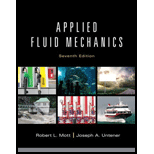
Calculate the force required to hold a flat plate in equilibrium perpendicular to the flow of water at
The force required to hold a flat plate in equilibrium perpendicular to the flow of water at 25m/s issuing from a 75-mm-diameter nozzle.
Answer to Problem 16.1PP
The force required, F=
Explanation of Solution
Given information:
Flow velocity of water
Calculation:
Calculate force using
Where,
Where, A is the area of the cross − section.
V is the velocity of flow.
Want to see more full solutions like this?
Chapter 16 Solutions
Applied Fluid Mechanics (7th Edition)
Additional Engineering Textbook Solutions
Shigley's Mechanical Engineering Design (McGraw-Hill Series in Mechanical Engineering)
HEAT+MASS TRANSFER:FUND.+APPL.
Statics and Mechanics of Materials (5th Edition)
Applied Statics and Strength of Materials (6th Edition)
Fluid Mechanics: Fundamentals and Applications
Vector Mechanics for Engineers: Statics, 11th Edition
- A tank open at the top with a water level of 1 m has a hole at a height of 0.5 m. A free jet leaves horizontally from the smooth hole. Calculate the distance X, where the jet strikes to the floor.arrow_forwardCalculate the force required to hold a flat plate in equilib rium perpendicular to the flow of water at 25 m/s issuing from a 75-mm-diameter nozzle.arrow_forwardA siphon pipe of diameter 250 mm contracts to a diameter of 100 mm over a vertical distance of 5 m before emptying into a river. If the pipe is full of water flowing at 0.1 m/s at the 250 mm section, what is the absolute pressure at this point, and what is the water velocity just before it vents into the river? You should assume the pipe to be frictionless and take atmospheric pressure to be 100 kPa.arrow_forward
- There are two coaxial cylindrical tubes of radius kR (the smallest) and R,between which is a Newtonian liquid. The outer cylinder rotates R ,while interior remains motionless. Calculate:a. The average speed of the fluidb. The torque applied on the outer cylinder.NOTE: T R = F r=R x darrow_forwardImpact of Jet In your own words, explain the reason for moving the counterbalance, putting different weight on the pan, and measuring the length of the weight pan and counterbalance distance. 2. Based on your observation, what is the difference between the force produced by the jet impact on a flat vane and an inclined vane? Explain the phenomenon.arrow_forwardA hemispherical tank of diameter 4 m contains water up to a height of 2.0 m. An orifice of diameter 50 mm is provided at the bottom. Find the time required by water (i) to fall from 2.0 m to 1.0 m (ii) for completely emptying the tank. Take Cd= 0.6arrow_forward
- A horizontal turbulent liquid jet of diameter D and average velocity Vj deflected at the angle by a cane mounted on a cart, this exerting a force on the vane, determine the opposing force needed to keep the plate moving at a constant velocity Vv. Neglect the viscosity and gravity forces.arrow_forwardIf the velocity in a 300-mm pipe is 0.50 m/s, what is the velocity in a 75-mm-diameter jet issuing from a nozzle attached to the pipe?arrow_forwardA horizontal pipe of diameter 25cm has a constriction of diameter of 5cm. The velocity of the water in the pipe is 1cm/s and the pressure is 10⁵ Pa. Calculate the velocity and pressure in the constriction. Include an illustration or drawing of the situationarrow_forward
- Consider an airplane flying with a velocity of 60 ft/s at a standard sea level conditions. At a point on the wing, the airflow velocity is 70 ft/s. Calculate the pressure at this point.arrow_forwardA crude oil of viscosity 0.9 poise and relative density 0.9 is flowing through a horizontal pipe of diameter 120 mm and length 12m.Calculate the difference of pressure at the two ends of the pipe, if 785 N of the oil is collected in a tank in 25 seconds.arrow_forwardConsider an airplane flying with a velocity of 60ft/s at a standard sea level conditions. At a point on the wing, the airflow velocity is 70ft/s. Calculate the pressure at this point. Assume the incompressible flow.arrow_forward
 Elements Of ElectromagneticsMechanical EngineeringISBN:9780190698614Author:Sadiku, Matthew N. O.Publisher:Oxford University Press
Elements Of ElectromagneticsMechanical EngineeringISBN:9780190698614Author:Sadiku, Matthew N. O.Publisher:Oxford University Press Mechanics of Materials (10th Edition)Mechanical EngineeringISBN:9780134319650Author:Russell C. HibbelerPublisher:PEARSON
Mechanics of Materials (10th Edition)Mechanical EngineeringISBN:9780134319650Author:Russell C. HibbelerPublisher:PEARSON Thermodynamics: An Engineering ApproachMechanical EngineeringISBN:9781259822674Author:Yunus A. Cengel Dr., Michael A. BolesPublisher:McGraw-Hill Education
Thermodynamics: An Engineering ApproachMechanical EngineeringISBN:9781259822674Author:Yunus A. Cengel Dr., Michael A. BolesPublisher:McGraw-Hill Education Control Systems EngineeringMechanical EngineeringISBN:9781118170519Author:Norman S. NisePublisher:WILEY
Control Systems EngineeringMechanical EngineeringISBN:9781118170519Author:Norman S. NisePublisher:WILEY Mechanics of Materials (MindTap Course List)Mechanical EngineeringISBN:9781337093347Author:Barry J. Goodno, James M. GerePublisher:Cengage Learning
Mechanics of Materials (MindTap Course List)Mechanical EngineeringISBN:9781337093347Author:Barry J. Goodno, James M. GerePublisher:Cengage Learning Engineering Mechanics: StaticsMechanical EngineeringISBN:9781118807330Author:James L. Meriam, L. G. Kraige, J. N. BoltonPublisher:WILEY
Engineering Mechanics: StaticsMechanical EngineeringISBN:9781118807330Author:James L. Meriam, L. G. Kraige, J. N. BoltonPublisher:WILEY





